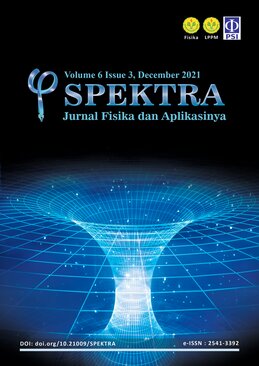LINEAR GENERATOR PROTOTYPE WITH VERTICAL CONFIGURATION OF SEA WAVE POWER PLANT
DOI:
https://doi.org/10.21009/SPEKTRA.063.05Keywords:
wave energy converter, attenuator, point absorber, terminatorAbstract
There are three types of potential energy sources in the sea: ocean wave energy, tidal energy, and ocean heat energy. Ocean wave energy is a source of considerable energy. Sea waves are an up and down movement of seawater where the energy of sea waves is generated through the effect of air pressure movement due to fluctuations in ocean wave movements. The Ocean Wave Power Plant can use ocean wave energy to convert it into electrical energy. A linear generator is a device that can convert the mechanical energy of linear motion into electrical energy. The application of the ocean wave energy conversion technology, a linear generator system is an electrical machine that functions to convert the mechanical energy of linear motion into electrical energy using the principle of electromagnetic induction. Wave Energy Converter (WEC) technology has been developed with various methods. From the various existing concepts and designs, in general, WEC technology can be classified into three main types, namely Attenuator (horizontal configuration), Point Absorber (linear configuration), Terminator (damping configuration).
References
[2] S. G. Como et al., “Ocean Wave Energy Harvesting: Off-Shore Overtopping Design,” Worcester Polytechnic Institute, 2015.
[3] Herbich, B. John, “Handbook of Coastal Engineering,” McGraw-Hill Professional, 2000.
[4] Wiegel, L. Robert, “Oceanographical Engineering,” Prentice-Hall, 1964.
[5] D. Hoffman, O. J. Karst, “The Theory of the Rayleigh Distribution and Some of Its Applications,” Journal of Ship Research, vol. 19, 1975.
[6] Nugroho et al., “Kajian Teknis Gejala Magnetisasi pada Linear Generator untuk Alternatif Pembangkit Listrik,” Jurnal Teknik POMITS, vol. 3, no. 1, 2014.
[7] Institut Teknologi Sepuluh November, 2014.
[8] https://www.supermagnete.de/eng/data_ta ble.php
[9] https://www.kjmagnetics.com/fieldcalculat or.asp
[10] E. McCormick, Michael, “Ocean Wave Enegy Conversion,” John Wiley & Sons, 1981.
[11] B. Drew, A. R. Plummer, M. N. Sahinkaya, “A Review of Wave Energy Converter Technology,” Proceeding of the institution of mechanical engineers Vol.223 Part A: Power and Energy, University of Bath, UK, 2009.
[12] http://www.electrical4u.com/full-wave- diode-rectifier/
[13] http://hydropower.inl.gov/hydrokinetic_w ave
[14] http://www.mstworkbooks.co.za/natural- sciences/gr9/images/gr9ec01-gd-0052.png
[15] http://adharikunae.blogspot.co.id/2009/08/gelombang-laut.html
Downloads
Published
How to Cite
Issue
Section
License
SPEKTRA: Jurnal Fisika dan Aplikasinya allow the author(s) to hold the copyright without restrictions and allow the author(s) to retain publishing rights without restrictions. SPEKTRA: Jurnal Fisika dan Aplikasinya CC-BY or an equivalent license as the optimal license for the publication, distribution, use, and reuse of scholarly work. In developing strategy and setting priorities, SPEKTRA: Jurnal Fisika dan Aplikasinya recognize that free access is better than priced access, libre access is better than free access, and libre under CC-BY or the equivalent is better than libre under more restrictive open licenses. We should achieve what we can when we can. We should not delay achieving free in order to achieve libre, and we should not stop with free when we can achieve libre.
 SPEKTRA: Jurnal Fisika dan Aplikasinya is licensed under a Creative Commons Attribution 4.0 International License.
SPEKTRA: Jurnal Fisika dan Aplikasinya is licensed under a Creative Commons Attribution 4.0 International License.
You are free to:
Share - copy and redistribute the material in any medium or format
Adapt - remix, transform, and build upon the material for any purpose, even commercially.
The licensor cannot revoke these freedoms as long as you follow the license terms.

 E-ISSN 2541-3392
E-ISSN 2541-3392  Focus & Scope
Focus & Scope  Editorial Team
Editorial Team  Reviewer Team
Reviewer Team  Author Guidelines
Author Guidelines  Article Template
Article Template  Author Fee
Author Fee  Publication Ethics
Publication Ethics  Plagiarism Policy
Plagiarism Policy  Open Access Policy
Open Access Policy  Peer Review Process
Peer Review Process  Retraction & Correction
Retraction & Correction  Licensing & Copyright
Licensing & Copyright  Archiving & Repository
Archiving & Repository  Contact
Contact  Mendeley
Mendeley 

